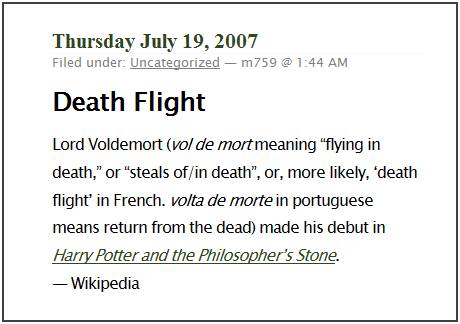Suggested by Peter J. Cameron's weblog post today on Halmos,
by a July 18 post in this journal on the Norwegian mathematician Abel,
by a link in the July 18 post to "Death Proof," and by today's
midday New York Lottery (459 and 7404)—
From July 4, 2004 (7404 interpreted as a date)—
"There are two unfortunate connotations of 'proof' that come from mathe-
matics and make the word inappropriate in discussions of the security of cryp-
tographic systems. The first is the notion of 100% certainty. Most people not
working in a given specialty regard a 'theorem' that is 'proved' as something
that they should accept without question. The second connotation is of an intri-
cate, highly technical sequence of steps. From a psychological and sociological
point of view, a 'proof of a theorem' is an intimidating notion: it is something
that no one outside an elite of narrow specialists is likely to understand in detail
or raise doubts about. That is, a 'proof' is something that a non-specialist does
not expect to really have to read and think about.
The word 'argument,' which we prefer here, has very different connotations."
— "Another Look at 'Provable Security',"
by Neal Koblitz and Alfred J. Menezes, July 4, 2004
(updated on July 16, 2004; October 25, 2004; March 31, 2005; and May 4, 2005)
As for 459, see Post 459 in this journal.
Related material: The Race, Crossing the Bridge, Aristophanic View, and Story Theory.









